Introduction to Squash Casserole Recipe
A Comforting Classic
Squash casserole recipe is a beloved dish known for its creamy texture and comforting taste. This staple of Southern cuisine brings together the simple goodness of yellow squash, onions, and cheese under a crispy, buttery cracker topping. It’s a versatile dish that fits perfectly on any dining table, especially during gatherings and festive seasons.
Why Squash Casserole is a Favorite
- Versatility: Whether served as a side dish or a main course, squash casserole easily adapts to various dietary preferences and occasions.
- Comfort: Its creamy consistency and rich flavor profile provide a comforting experience, making it a favorite during both special and everyday meals.
Explore the history of squash in Southern cooking to understand how this simple vegetable became a regional star.
Expectations from This Article
In this article, you’ll gain insights into everything from the basic recipe to advanced tips that elevate this classic dish. Regardless of your cooking expertise, from beginner to seasoned chef, these suggestions will guide you in perfecting the craft of preparing squash casserole. Additionally, you’ll discover how to adapt the recipe to meet different dietary needs and learn how to handle common cooking challenges.
Learn more about creative casserole toppings to add a unique twist to your dish.
By the end of this read, you’ll be equipped with all the information you need to create a delicious squash casserole that impresses at any meal. Whether looking for a traditional approach or something uniquely yours, this guide will provide all the necessary steps and ideas.
Basic Recipe for Squash Casserole Recipe
Print
Classic Squash Casserole Recipe
- Total Time: 40 minutes
- Yield: Serves 6
- Diet: Vegetarian
Description
This classic squash casserole recipe combines tender yellow squash, savory cheese, and a crispy cracker topping. It’s a comforting and delicious dish perfect for any occasion.
Ingredients
- 4 cups sliced yellow squash
- ½ cup chopped onion
- ¼ cup water, or more as needed
- 35 buttery round crackers, crushed
- 1 cup shredded Cheddar cheese
- 2 large eggs, beaten
- ¾ cup milk
- ¼ cup butter, melted
- 1 teaspoon salt
- ground black pepper to taste
- 2 tablespoons butter
Instructions
- Preheat oven to 400°F (200°C).
- In a large skillet, combine squash, onion, and water. Cook over medium heat until squash is tender, about 5 minutes. Drain well.
- In a large bowl, combine the squash mixture, crackers, and cheese. Mix well.
- In a separate bowl, mix together eggs, milk, melted butter, salt, and pepper. Stir into the squash mixture.
- Transfer the mixture to a 9×13 inch baking dish. Dot with the remaining 2 tablespoons of butter.
- Bake in the preheated oven for 25 minutes, or until lightly browned.
Notes
- This squash casserole recipe is perfect for a family dinner and can be easily doubled for larger gatherings. Adjust the seasoning to taste, and feel free to add herbs like thyme or rosemary for extra flavor.
- Prep Time: 15 minutes
- Cook Time: 25 minutes
- Category: Side Dish
- Method: Baking
- Cuisine: American
Nutrition
- Serving Size: 1 serving
- Calories: 250
- Sugar: 3g
- Sodium: 660mg
- Fat: 18g
- Saturated Fat: 9g
- Unsaturated Fat: 7g
- Trans Fat: 0g
- Carbohydrates: 15g
- Fiber: 2g
- Protein: 8g
- Cholesterol: 100mg
For more variations, you can explore Food Network’s Squash Casserole Recipe, which offers additional inspiration and tips.
STEPS
Step 1: Gather all ingredients.

Step 2: Set the oven temperature to 400 degrees Fahrenheit (200 degrees Celsius) before heating
Step 3: Put squash and onion into a sizable skillet set over medium heat and add water. Seal with a lid and simmer until the squash softens, typically around 5 minutes. After draining thoroughly, transfer to a large bowl.
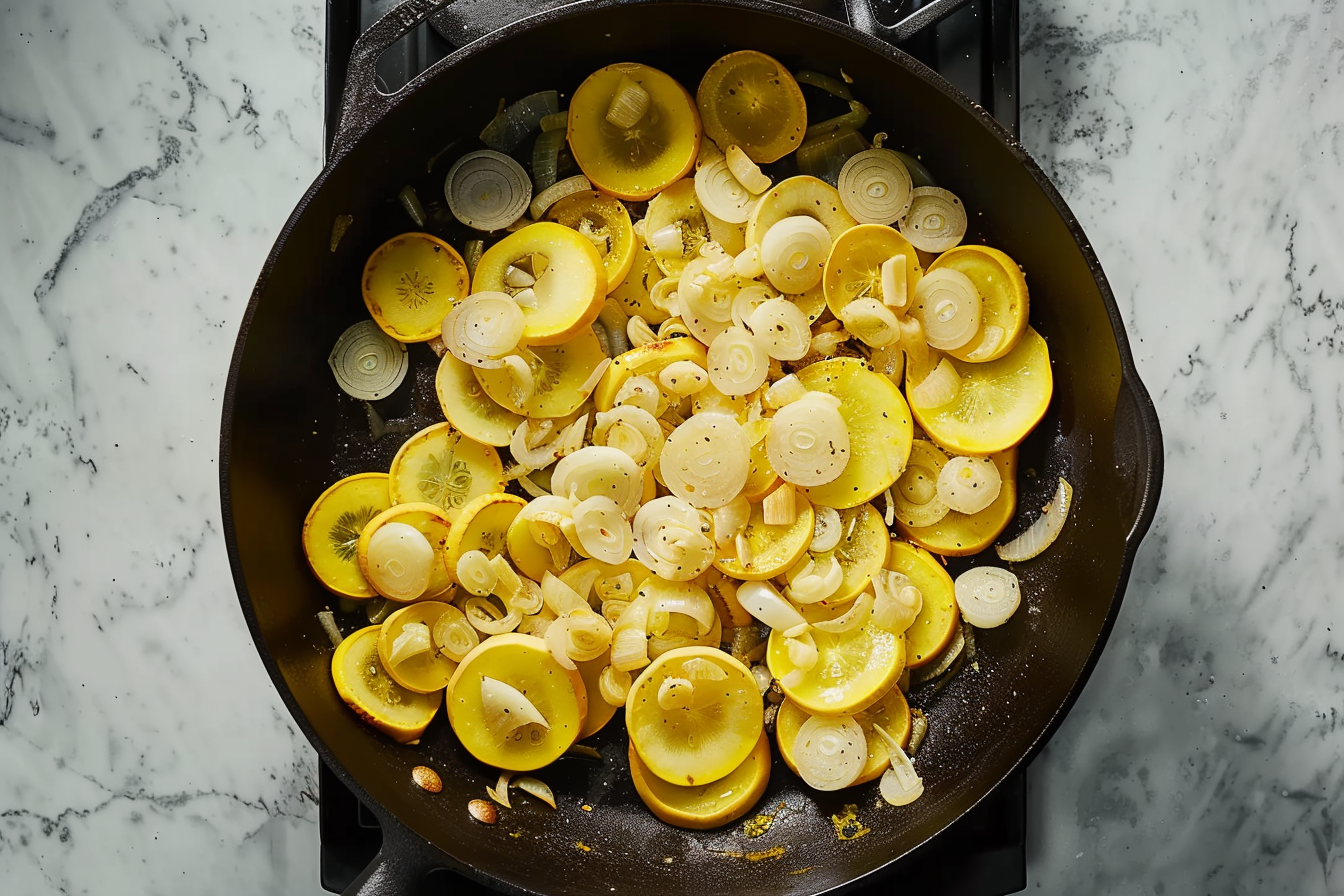
Step 4: Combine the cracker crumbs and cheese in a medium-sized bowl. Fold half of this mixture into the cooked squash and onions.

Step 5: Blend eggs and milk in a small bowl, then incorporate into the squash mixture.
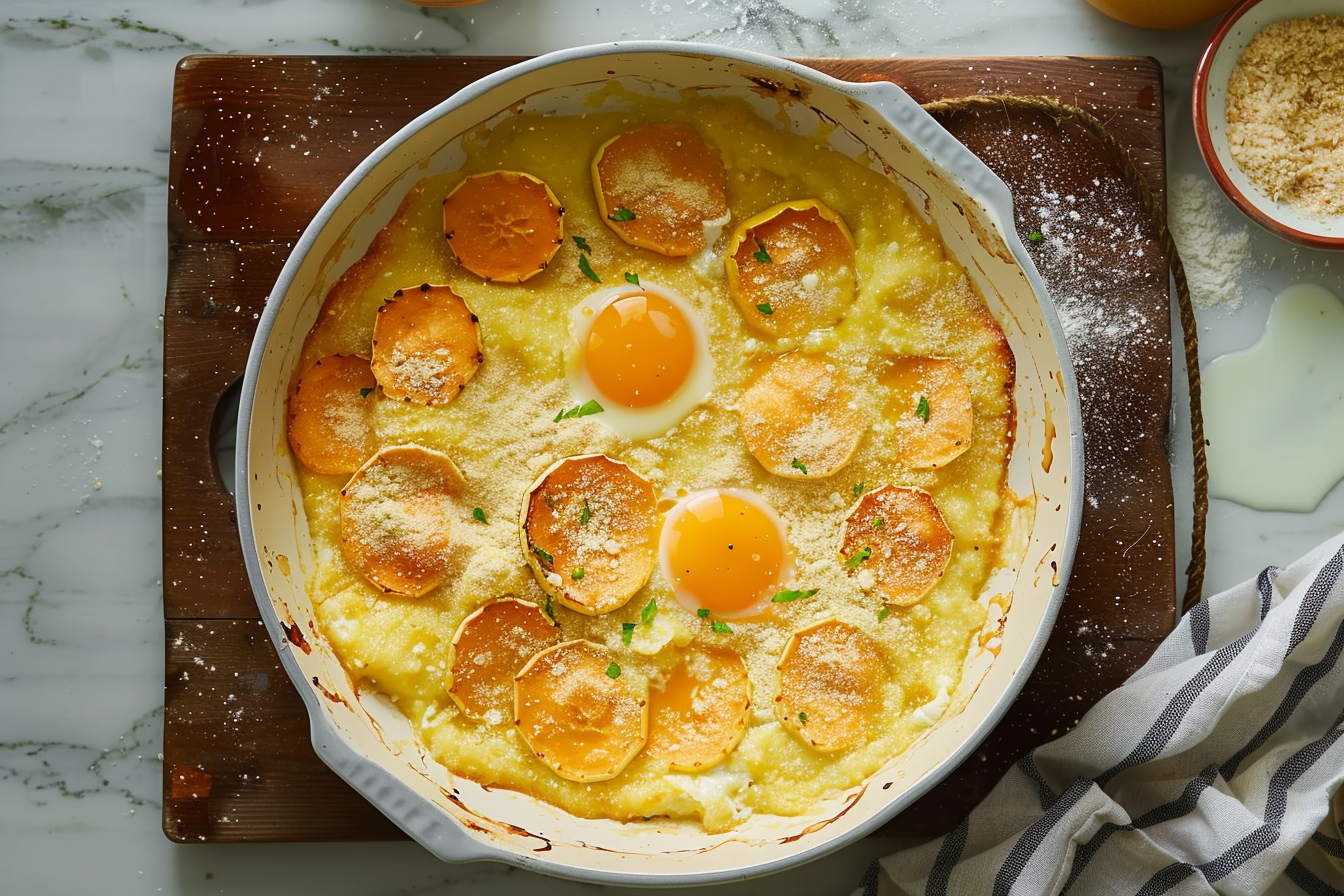
Step 6: Mix in 1/4 cup of melted butter and season with salt and pepper. Transfer to the baking dish that’s been prepped. Top with the leftover cracker mixture and dot with 2 tablespoons of butter.

Step 7: Cook in the oven, already heated, until it achieves a light golden color, approximately 25 minutes.
Step 8: Enjoy it warm and savor the taste!

Advanced Techniques
Infusing Flavor
Elevate your squash casserole by incorporating fresh herbs like thyme, rosemary, or basil. These herbs enhance the squash’s natural sweetness and add complexity to the dish. Additionally, incorporating a variety of cheeses, like Parmesan or Gruyère, can enhance the flavor profile. A dash of nutmeg or a sprinkle of red pepper flakes can also provide a subtle kick.
Texture Variations
Perfecting the texture of a squash casserole can significantly improve the dish. For a crispier topping, use panko breadcrumbs mixed with melted butter instead of crackers. For an extra crunch, consider blending in a handful of finely chopped nuts such as pecans or almonds. If you prefer a creamier base, consider adding a dollop of sour cream or Greek yogurt to the squash mixture before baking.
Presentation Tips
Presentation is key when serving squash casserole. For a visually striking presentation, top the dish with fresh herbs or a dusting of paprika. Using a colorful baking dish can also enhance the visual appeal. If you’re serving this dish at a gathering, portion it into individual ramekins for a more elegant presentation.
For more advanced techniques, you can refer to Food Network’s Squash Casserole Recipe which offers additional tips and variations.
Incorporating these advanced techniques can transform your squash casserole from a simple side dish into a standout centerpiece. Experiment with various ingredients and textures to discover your ideal combination. By incorporating these elements, you’ll craft a dish that is both a culinary delight and a visual masterpiece on the table. Remember, the key to a perfect squash casserole is balancing flavors and textures to achieve a harmonious result.
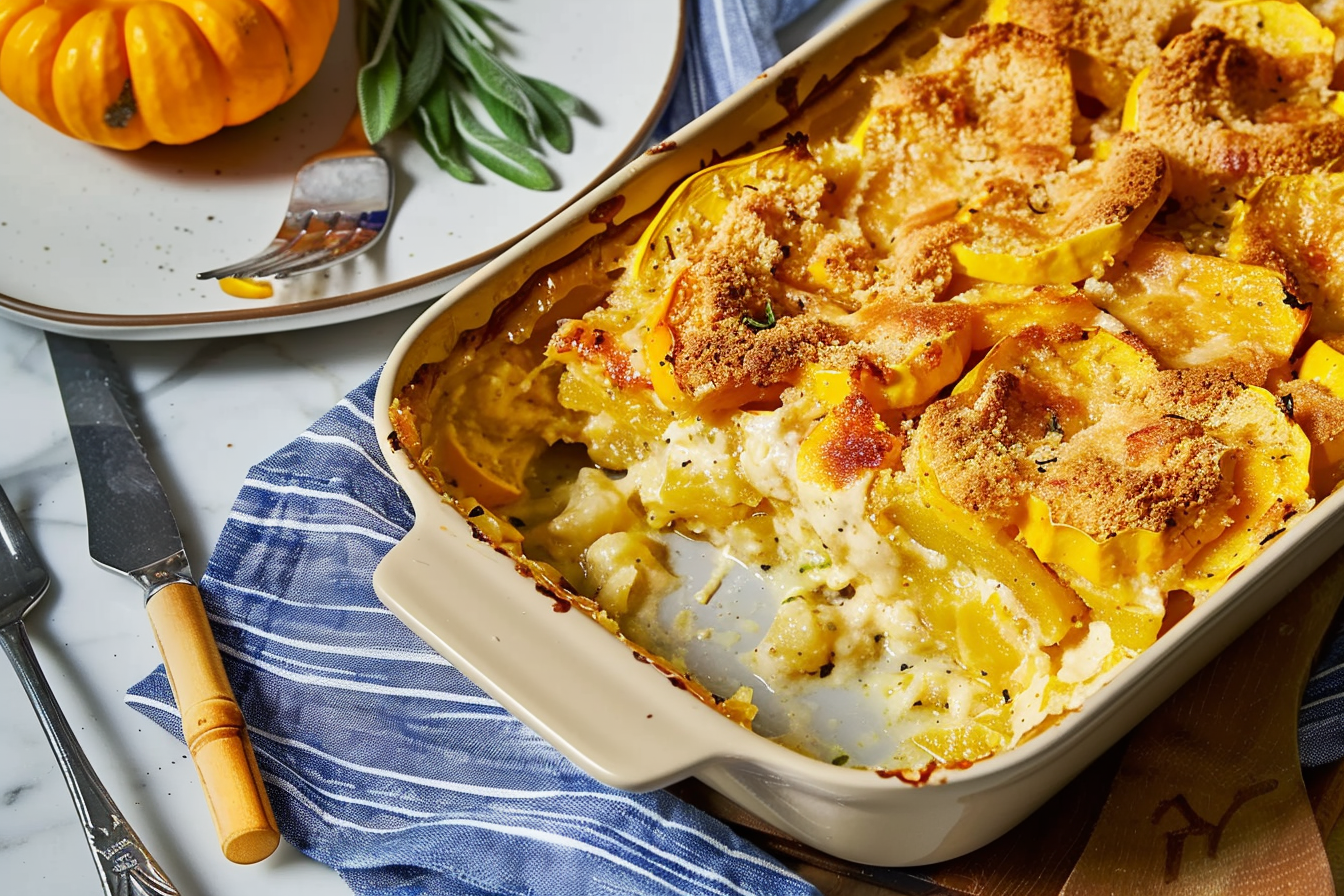
Maintenance Tips
Storage
To maintain the freshness and flavor of your squash casserole, proper storage is essential. Once the casserole cools to ambient temperature, shift the remaining portions into a container that is airtight. Place it in the refrigerator to maintain its freshness for as long as four days. Consider freezing if you plan on storing it beyond a few days. Encase the casserole securely in aluminum foil and tuck it into a bag suitable for freezing. This method allows it to remain fresh for up to 3 months.
Reheating
Reheating squash casserole correctly helps preserve its original texture and taste. Preheat your oven to 350°F (175°C) when ready to reheat from the refrigerator. Place the casserole in a dish appropriate for oven use, cover with foil to keep moisture intact, and warm it for 20-25 minutes or until thoroughly heated. Before reheating a frozen casserole, defrost it in the fridge overnight. To ensure even heating, stir the casserole halfway through the process.
Shelf Life
Knowing the shelf life of your squash casserole can help you manage your meals better and prevent food waste. Consume refrigerated leftovers within 4 days to enjoy the best flavor and texture. Keep frozen sections for as long as three months, providing a practical solution for meals ahead. To keep track of how long your casserole has been stored, label your containers with the date.
Proper storage, reheating techniques, and understanding the shelf life will ensure that you can enjoy this comforting dish anytime, without sacrificing its quality.
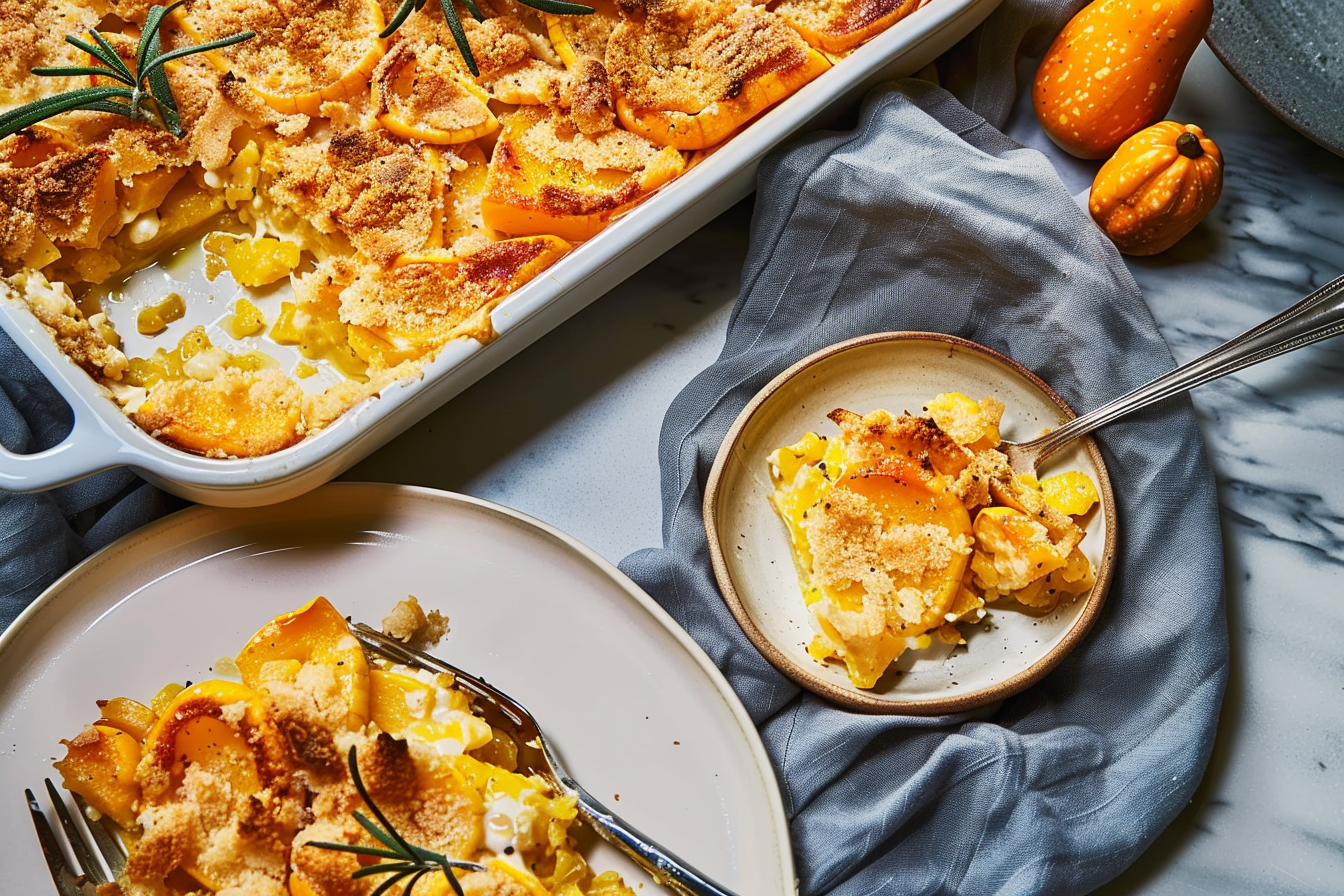
Dietary Adaptations
Gluten-Free Version
Creating a gluten-free squash casserole is simple and delicious. Exchange buttery round crackers with gluten-free crackers or breadcrumbs. Confirm that all additional ingredients, like cheese and butter, carry a gluten-free certification. Follow the same instructions as the original recipe, and you’ll have a tasty casserole that caters to those with gluten sensitivities without sacrificing flavor.
Vegan Version
Convert the traditional squash casserole to a vegan-friendly dish by replacing dairy and eggs with plant-based substitutes. Use a vegan cheese that melts well, such as a cashew or soy-based cheese. Use a mixture of flax or chia seeds combined with water as an egg substitute, which mimics the binding properties of eggs. Replace the milk with options like almond, soy, or oat milk, and opt for vegan butter instead. These changes create a casserole that is both satisfying and cruelty-free.
Low-Carb/Keto Option
To adapt the squash casserole for a low-carb or keto diet, make some specific changes. Replace the crackers with crushed pork rinds or almond flour to reduce carbs. Opt for heavy cream over milk to enhance richness and comply with keto dietary standards. Incorporate additional low-carb vegetables, such as spinach or cauliflower, to enhance the dish’s nutritional value while keeping it low in carbohydrates.
Additional Tips
When adapting the squash casserole to different diets, it’s important to taste and adjust the seasoning as needed. These substitutions can alter the flavor profile, so adding extra herbs or spices might be necessary to achieve the desired taste. Always ensure that any substitute ingredients align with the specific dietary requirements to avoid any unwanted reactions or dietary conflicts.
By making these dietary adaptations, you can enjoy squash casserole regardless of your dietary preferences or restrictions. Whether you need gluten-free, vegan, or low-carb options, there are simple and delicious ways to modify this classic dish to suit your needs.

Frequently Asked Questions (FAQs)
Can I use different types of squash?
Absolutely! While yellow squash is traditional, you can use zucchini, butternut squash, or a mix of various squashes. Each variety contributes its distinct taste and texture to the squash casserole. Mixing different varieties can add visual appeal and a richer taste profile.
How can I prevent my casserole from getting too soggy?
To avoid a watery squash casserole recipe, ensure you drain the cooked squash thoroughly before mixing it with other ingredients. Additionally, you can sprinkle a little salt on the sliced squash and let it sit for 10 minutes to draw out excess moisture. Pat the squash dry with paper towels before cooking.
Is it feasible to prepare this dish beforehand?
Yes, squash casserole is an excellent make-ahead dish. Assemble the casserole up to the baking step, cover, and store it in the fridge for no more than 24 hours. When you’re ready to serve, simply bake it in a preheated oven, adding an extra 10-15 minutes to the cooking time if it’s coming straight from the fridge.
What if I don’t have crackers?
If you don’t have crackers on hand, you can use bread crumbs, crushed cornflakes, or even panko as a topping for your squash casserole. These alternatives will provide a similar crunchy texture.
Can I add meat to my squash casserole?
Certainly! Adding cooked bacon, sausage, or shredded chicken can turn your squash casserole into a hearty main dish. Ensure that all meat included is thoroughly cooked prior to mixing it into the casserole.
What steps can I take to add more flavor to my casserole?
Enhance the flavor of your squash casserole by adding garlic, onions, or different cheeses. Spices like paprika, thyme, or rosemary can also add depth. Feel encouraged to try various herbs and spices to discover the ideal blend for your taste.
These tips and answers should help you troubleshoot common issues and customize your squash casserole to your liking. Whether you’re making it for the first time or looking to perfect your technique, these FAQs offer practical solutions and creative ideas.
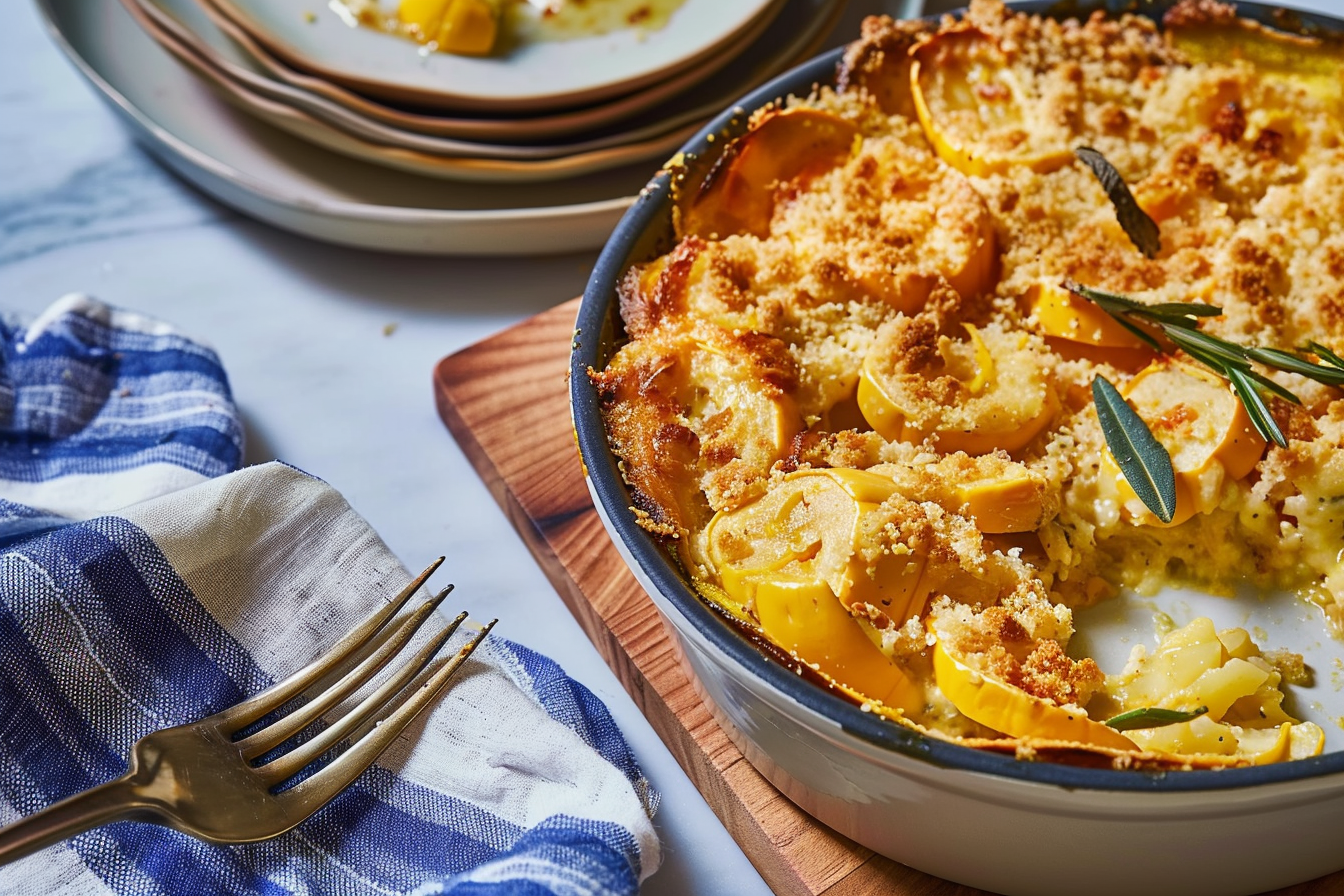
Conclusion
Summary
In conclusion, squash casserole recipe is a versatile and comforting dish that can be adapted to suit various tastes and dietary needs. Whether you stick to the classic recipe or experiment with advanced techniques and dietary adaptations, this casserole remains a beloved favorite. By following the steps outlined in this article, you can create a delicious and satisfying squash casserole for any occasion.
Encouragement
We encourage you to try making your own squash casserole at home. It’s a straightforward recipe that yields impressive results. Don’t be afraid to get creative and personalize it with your favorite ingredients. Whether you add extra cheese, different herbs, or a unique topping, making it your own will only enhance the experience.
Additional Resources
For those looking to explore more recipes and cooking tips, there are numerous resources available online. Many websites offer variations and additional advice to help you perfect your squash casserole. Remember, cooking is all about experimentation and enjoying the process.
Call to Action
Finally, we’d love to hear from you! Share your squash casserole experiences and any unique twists you’ve added. Your feedback helps others discover new ways to enjoy this classic dish. Happy cooking, and enjoy every bite of your delicious squash casserole!
